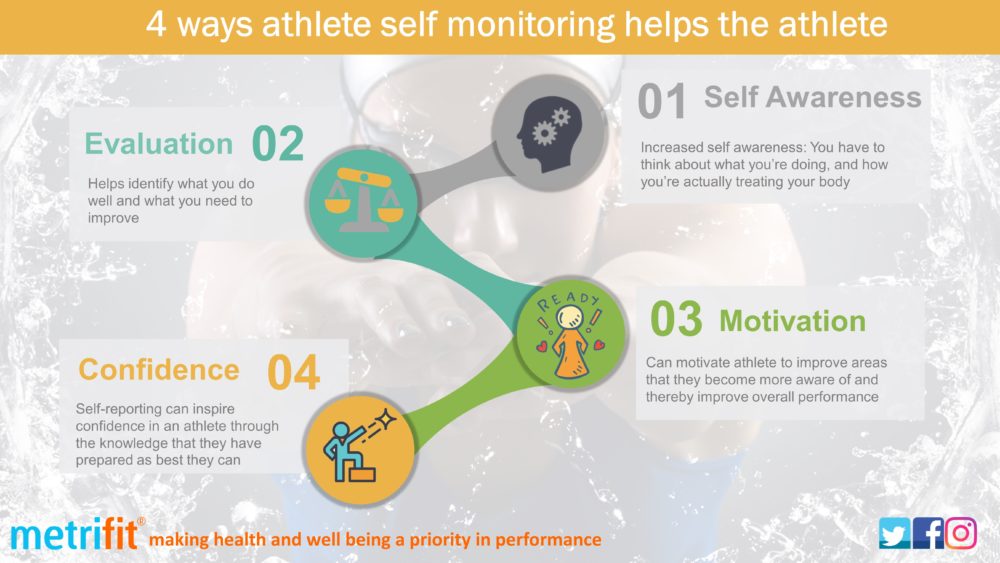Why you should be monitoring athlete well-being

Many factors influence athletic training and performance, and it is essential for coaches and athletes to be aware of the extent of their impact. Coaches usually meet their athletes in a team environment with a focus on practice and/or competition. They may see their athletes regularly, but they don’t really have the time to go around each and every athlete to check in and ask questions.
The interpersonal dynamic between a coach and an athlete of course is hugely important and it is an essential and integral part of all coaching. This human connection and communication are not something that will, nor should be removed. Athlete self-monitoring tools allow a coach to have a consistent daily view of the well-being and training responses of his/her athletes. Rather than having 40 conversations on the pitch side with each athlete, self-monitoring tools allow coaches, to in a sense, have those 40 conversations and be able to pinpoint who needs their attention and why.
In The use of wellness questionnaires in football, the Barça Innovation Hub state
Essentially, athlete monitoring acts as a prompt for starting a conversation between coaches and athletes and provides a means by which variables can be manipulated to help athletes to perform their best. Share on XIn sports such as football, where each team has 20 to 25 players, it is not viable to talk to each one of them on a daily basis to see how they feel, how they slept, or how fatigued they feel. Wellness questionnaires allows us to obtain this valuable information in a fast, easy-to-process way without requiring an individual conversation with each member of the group. The use of these questionnaires is therefore growing exponentially. In fact, they’re now considered the second most important monitoring tool for injury prevention among the teams’ head medical officers included in the UEFA Elite Club Injury Study.
Monitoring can make a difference
One of the key elements of athlete monitoring in recent times has been the ability to assess the wellness of the athlete. Being able to pinpoint an athlete’s physical well-being is obviously essential but in the sporting world where fractions of seconds and millimeters can make all the difference, general well being can be a vital factor in getting the most out of a training/practice session or competitive performance. It can also be a significant factor, through early intervention, in helping to prevent injury and fatigue – issues which can have a hugely detrimental effect on an athlete.
The key to monitoring is being able to
- identify potential difficulties at the earliest possible stage
- take actions to help optimize preparations and training
- ensure that your athletes are fit and healthy – both physically and mentally – and ready to perform
Benefits of Athlete Monitoring
Monitoring is only useful if it provides information or leads to practices that ultimately improve performance. A well-implemented monitoring system with a clear knowledge of how and why it is being used has many benefits including:-
- helps drive professional conversations and actionable tasks to enhance sporting results and the health and well-being of athletes
- monitoring an athlete’s training program helps ensure they are in the best possible condition to train and helps to optimize training load and rest and recovery
- gives the athlete an active role in the monitoring process and develops self-awareness and accountability
- provides a central hub of data allowing the coaches to see the ‘big picture’ and to evaluate information and inform their decision making
- puts meaningful data into the hands of coaches who can make effective use of it
- monitoring key life stressors allows coaches and staff to educate on the affects that poor sleep hygiene, stress and anxiety have on performance and on athlete health and well-being

What variables are important to monitor?
When introducing a monitoring system coaches need to identify the areas in an athlete’s program that should be monitored to improve overall well-being and performance.
It is important that coaches look at what factors should be monitored and have a clear understanding of the difference between what is ‘need to know’ information and what is ‘nice to know’ information Share on X
This helps drive the success of any athlete monitoring program – you immediately can see advantages in what you are doing and have the knowledge and the resources to act on the information.
Research has outlined the key areas that should be part and parcel of a self reporting monitoring tool. These include:-
Training
Ensuring an athlete is in the best possible condition to compete at their best when it matters most is one of the greatest challenges faced by both an athlete and their coach. It is essential for an athlete to push themselves to the limit in training – but the key is knowing when you have reached that limit. This can often be the most difficult part of the process. Going just that little bit too far can undo much of the good work and bring on factors that are detrimental to an athlete’s performance. Monitoring training is essential to make the training meaningful and keep on track with your goals.
Mood
Can mood state really affect performance on the field of play in sport? Can feeling happy, sad, anxious, angry or indifferent have a major influence (if any) on how a player / athlete performs during a match / race? The answer is a resounding “Yes”. An athlete’s mood state can have a huge impact on their performance, depending on mood type and severity. It is impossible to measure what you can’t see, and some athletes are exceptionally good at hiding how they really feel. Including mood evaluation is an important element of athlete self-monitoring.
Sleep
Sleep is important for everyone; but in the case of the athlete, it may be that they need more recovery and more sleep as they push their bodies through intensive training and competition. Monitoring sleep patterns is now regarded as a must for athletes and coaches. Quality sleep should be a key component of any elite athlete’s routine – it is akin to a foundation block on which everything else rests on.

Energy/Fatigue
Energy levels are required to be at optimum levels if an athlete is going to perform their best. All the different areas of lifestyle draw on an athlete’s available energy resources. Warning signs of fatigue, burnout and other issues can be monitored through use of relevant questionnaires and daily metrics.
Muscle Soreness
There is a clear effect of training load on muscle soreness and fatigue. Monitoring soreness can provide key information to both coaches and athletes and can help with individualized training programs to help ensure that the athlete is kept fit and healthy.
Nutrition and Hydration
Top level athletes and players train and compete multiple times per week, and even sometimes per day. For this, athletes need adequate fuel to maintain their level of performance. A well-balanced diet provides athletes with the fuel to perform. The food we eat impacts our strength, endurance, training, performance, recovery and well-being. A failure to adequately fuel will mean athletes will not perform their best.
Stress and Mental Health
Stress, regardless of where it stems from, can have a direct impact on how an athlete performs. More importantly, it can interfere with their ability to perform routine tasks such as interacting with others, focusing in school or at work, sleeping, eating, and maintaining overall health. Athletes are often slow to seek help. Monitoring mood state, stress levels and an athletes’ own perception of how ready they are to perform can pinpoint issues that need to be addressed that could potentially aid in maintaining the health of athletes both physically and psychologically.
Injury and Illness
Monitoring assists in identifying such potential problems as injury, illness, and burnout. Each of these factors can hamper an athlete’s ability to train consistently. If they can avoid missing training sessions, they will be better prepared to achieve success.
Roadblocks and Compliance
Ensuring that athletes enter genuinely accurate information is one of the main challenges to a monitoring program. It is a question that initially concerns some of our clients. In reality, not only do athletes buy-in to the system, but they also take on greater responsibility and ownership. A monitoring system also creates a strong relationship between athlete and coach which also contributes to improving performance. It is vital to explain to players the importance of honesty when filling out any wellness questionnaire. Player health and well-being should be at the fore and players shouldn’t be concerned about the assessment having an impact on their participation in the next game. Honesty and trust in the process is key. Over time players will see the co-relation between their wellness and performance and become more self-aware about the importance of sleep hygiene and how stress and anxiety can affect their performance.
Some coaches fear that the process is too complicated and time consuming and, as a result, will prove counterproductive and interfere with training time. The key is to use clear and relevant questions with a range of response options that are easily understood, allowing for swift and accurate inputs.
The final major challenge with implementing a monitoring system is making sure that we not only gather specific information that is useful but also that we use the information effectively in a training program to improve results.
Conclusion
An athlete monitoring system does make sense and no current literature suggests otherwise. First and foremost, a successful athlete monitoring system should be devised based on a sound theoretical framework. That is, it must have some academic literature to back up what it actually does. For example, monitoring athlete training loads, and athlete self-monitoring in general are methods that have been scientifically proven to be beneficial to athlete and coach.
The difficulty is often in collecting and collating all this information and transforming it into visualizations that are understood by and provide insight to coaches and athletes. It needs to be cost-effective, intuitive and easy to use whilst balancing quantity of data collated with quality and effectiveness. Data logging should be simple and quick and should be able to integrate with automated data from devices as required. The system should be intuitive and be available on all types of devices including mobile phones to ease the logging process for the athlete and help with buy-in and distribution of feedback.
How Metrifit can help
Regardless of what monitoring tool or application you decide to use for your athletes and team, it is crucial that you understand why you are monitoring and how you are going to use the data to inform your decision making process. By monitoring key areas, coaches can help manage the 24-hour athlete and have a positive effect on athletic performance.
Successful change is about small steps in the right direction rather than giant leaps forward. Monitoring is key to getting the balance right. Share on X
Metrifit’s approach not only covers the physical requirements of a particular sport but also helps the coach derive the benefits of other factors that have a significant influence on an athlete’s well-being: training, body, nutrition, mind, and sleep. In this short video, we explain how Metrifit works for both the athlete and the coach.
To find out more contact us at or click on ‘Request Demo’ below.
Follow us on social media where we post regular blogs related to sports, performance and well-being.
Monitoring Athletes: What you should know today by Carl Valle
Sleep and Athletic Performance by Andrew Watson
Focusing on Student-Athletes’ Mental Health
What is mental fatigue in elite sport? Perceptions from athletes and staff
Monitoring training is critical for success By Vernon Gambetta
































 Previous Post
Previous Post Next Post
Next Post





